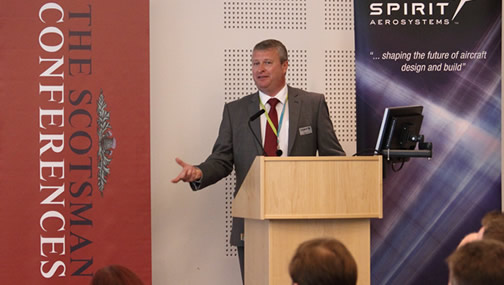Prestwick and its role in the future of the UK aerospace industry
9 September 2013Last Thursday, our Prestwick Control Centre hosted a conference as part of a series of events taking place during the Prestwick World Festival of Flight 2013, a 10-day celebration of a century of aviation at Prestwick.
The conference as a whole focused on ‘The Future of the UK Aerospace Industry’ and highlighted the success of the civil aerospace hub in and around Prestwick, placing it in a UK, European and global context. Key issues discussed by speakers, who included Michael Moore, Secretary of State for Scotland, covered new technology, training and skills, research and development – and what the future might hold – to ensure the industry can maximise opportunities for future growth.
I was fortunate to speak at the event and talked about air traffic services for the next generation as well as the importance of our centre in Prestwick, which is a key element in the Global Air Traffic network – and more specifically as part of Europe’s North Atlantic Gateway.
The Prestwick Centre is one of two air traffic control centres run by NATS and has responsibility for the largest area of airspace in Europe, providing ATC services to 1.1 million aircraft per year.
Although the current Centre was opened in 2010, making it one of the most modern centres in Europe, the ATC relationship with Ayrshire actually goes back some 70 years with the early centre operations, Redbrae, dating back to the 1940s.
The transformation in the technology and method of operations since Redbrae has been considerable but many argue that the air traffic management industry in Europe, and beyond, is still based around concepts that don’t make the most of the capabilities of today’s modern aircraft fleets. So the European Commission launched the Single European Sky (SES) programme in 1999 with the objective of modernising the European ATC network.
As the SES title would suggest, the strategic intent is not to have 28 European States managing their airspace independently at some 65 control centres – which is what exists today. It also includes harmonising technologies to work inter-operably across Europe through a major research, development and implementation programme called SESAR.
This initiative aims to achieve improvements in ATC capacity, reduce ATC service provision costs, enhance safety and do more to address the environmental impact of aviation – in a harmonised approach across Europe. Worldwide there are similar programmes with, for example, the USA administering their equivalent called NextGen.
Fortunately, Prestwick’s geographic location gives us the opportunity to develop influential and meaningful relationships. The North Atlantic portion of the airspace covered by Prestwick means we control aircraft transitioning between Europe and North America and, by virtue of that airspace, allows us to be a key driver in SESAR-NextGen harmonisation.
The SES programme is currently going through its third EU legislative revision, but it is clear that ATC is most definitely on a transformational path.
So what will all this mean for the NATS Prestwick Control Centre?
In short – new technology, new methods of operation and a requirement to develop employees’ operational capability to ensure that we maintain the safety and service qualities that NATS is renowned for.
It is undoubtedly a very exciting time in the aviation industry. Not only are new technologies enabling revolutionary change in how air traffic is managed, but countries around the world are looking at successful models of liberalised ATC service provision – like NATS – and considering different ways of delivering their service.
In the UK, the CAA’s Future Airspace Strategy (FAS) is already modernising the airspace system.
By the early 2020s, our ATC operation will be very different from today, comprising a new ATC working environment and technology; new airspace structures to optimise aircraft trajectories; reductions in CO2 emissions; diminished environmental impacts; and more efficient airport operations.
At NATS, we engage with stakeholders across the aviation community and that has helped us to keep ourselves at the very forefront of the industry. We are able to respond quickly to changing demands and integrate new technologies and that is what we will continue to do at Prestwick to ensure we lead the charge of change and meet current and future airspace needs.
Comments
Please respect our commenting policy and guidelines when posting on this website.


10.09.2013
19:18
mike thomson
I was wondering, is this the text from Alastair’s presentation at the Festival of Flight event?